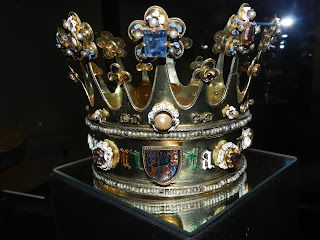A recent visit to the Cathedral
Treasury of Aachen has given me some additional information about a little
object which has been in the possession of the Treasury for nearly 640 years.
It is the coronet of a Duchess of Burgundy, Margaret of York, daughter of the
Duke and Duchess of York, Richard Plantagenet and Cecily Neville and sister to
the Kings Edward IV and Richard III.
Margaret's coronet is said to be the
only medieval British royal crown still surviving. This, however, is not true,
there is another crown worn by Blanche,
daughter of Henry IV, at her marriage to Louis III, the Elector Palatine, in
1402, and still exists in Munich. Naturally this fact does not make Margaret’s
crown any less valuable and interesting.
There is a possibility that Margaret wore her crown already in 1461 at the coronation of her brother Edward IV when she was 15 years of age and that it was adjusted for her in 1468 when she wore it at her wedding to Charles the Bold, Duke of Burgundy, on 3 July in Damme, near Bruges. It is very notable that this crown is incredibly small, with a diameter across the base of just under five inches, and a maximum height of just over five inches. The size does not make it any less splendid than it is. Between each rose appear letters covered with transparent green, white and red enamel forming the name Margarit(a) de (Y)o(r)k and the initials C and M adjoined with a knot appear repeatedly. The white rose of York with a diamond wreath in the front, corresponds with the enamelled coat of arms bearing the arms of Burgundy, France and England quarterly, which symbolises the marriage. Furthermore the circlet is made of gilded silver, ornamented with precious stones; a diamond cross, adorned with two edgings of pearls and surmounted by eight large fleurons; the one in the front is quadrifoliate (4 leaves)with a large ruby in a claw setting and mounted on a white rose, the other seven quinquifoliate (5 leaves) ornamented with pearls and sapphires. Below this is a small gold rose ornamented with emeralds.
There is also a leather case
for the coronet, the sides ornamented with a design of dragons and gothic foliage
pressed into the leather. On top are the arms of Burgundy impaling England and
France quarterly. The arms are surrounded by flints, the emblem of the Order of
the Golden Fleece. Around the edge are again the initials C and M joined by
knots, and, repeated five times, ‘Bien en Avienie’, ‘May good come of it’ the
motto of Margaret of York.

So how did Margaret's crown ended up in Aachen? It is known that Margaret travelled to Aachen on a few occasions and it is recorded that she spent some time here on 22 July 1474 and that either on this occasion or another, she donated her crown to the admired statue of the Virgin Mary of the cathedral. A child-sized crown was also constructed for the Christ Child. This, unfortunately, does not exist any longer. Up until now, the crown serves as jewellery during the procession with relics.
















